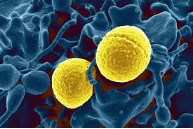Advancing Wound Care: A Hydrocarbon Ointment Formulated with Oregano vulgaris for Antibacterial Action Against Staphylococcus aureus
Main Article Content
Abstract
The challenge of wound healing is significantly compounded by the risk of infections, notably those caused by the pathogen, Staphylococcus aureus. Oregano (Oregano vulgaris) is a plant with strong antibacterial effects mostly due to its thymol and carvacrol components. There are attempts to employ this plant in novel ways. The present study was conducted to formulate and evaluate a hydrocarbon-based herbal ointment derived from oregano, as well as evaluate its antibacterial activity against S. aureus. Dried Oregano vulgaris leaves were extracted with 96% ethanol by maceration and oregano oil is obtained using the distillation method. The extract was further subjected to phytochemical screening. The ointment was formulated at 3, 6, and 9% concentrations. The formulated ointment was evaluated for physical properties and organoleptic characteristics, such as pH, homogeneity, spreadability, viscosity, and adhesion. The antibacterial activity against S. aureus at various concentrations (ranging from 1.5x105 to 1.5x108 CFU/ml) was also evaluated. Remarkably, the results revealed a positive correlation between the concentration of the herbal ointment and its antibacterial activity against S. aureus. The 3% Oregano vulgaris herbal ointment demonstrated ideal physical properties and antibacterial activity. The findings of the study suggest the effectiveness of oregano as a novel, natural therapeutic agent for treating skin wound infections caused by S. aureus. Future studies must seek clinical validation and formulation optimization to harness its full therapeutic benefit
Downloads
Article Details
Section

This work is licensed under a Creative Commons Attribution-NonCommercial-NoDerivatives 4.0 International License.
How to Cite
References
Gonzalez ACDO, Costa TF, Andrade ZDA, Medrado ARAP. Wound healing: A literature review. A Bras Dermatol. 2024; 91(5):614–20. DOI: https://doi.org/10.1590/abd1806-4841.20164741
Tong SYC, Davis JS, Eichenberger E, Holland TL, Fowler VG. Staphylococcus aureus infections: Epidemiology, pathophysiology, clinical manifestations, and management. Clin Microbiol Rev. 2015; 28(3):603–61. DOI: https://doi.org/10.1128/CMR.00134-14
Gherardi G. Staphylococcus aureus infection: Pathogenesis and antimicrobial resistance. Int J Mol Sci. 2023; 24(9):8182. DOI: https://doi.org/10.3390/ijms24098182
Kosakowska O, Węglarz Z, Pióro-Jabrucka E, Przybył JL, Kraśniewska K, Gniewosz M, et al. Antioxidant and antibacterial activity of essential oils and hydroethanolic extracts of Greek Oregano (O. vulgare L. subsp. hirtum (Link) Ietswaart) and common Oregano (O. vulgare L. subsp. vulgare). Molecules. 2021; 26(4):988. DOI: https://doi.org/10.3390/molecules26040988
Soltani S, Shakeri A, Iranshahi M, Boozari M. A Review of the phytochemistry and antimicrobial properties of Origanum vulgare L. and subspecies. Iran J Pharm Res. 2021; 20(2).
Kaushal D, Upadhyaya N. Review on ointment. Int J Pharm Sci Med. 2022; 7(10):30–8. DOI: https://doi.org/10.47760/ijpsm.2022.v07i10.003
Hać-Szymańczuk E, Cegiełka A, Karkos M, Gniewosz M, Piwowarek K. Evaluation of antioxidant and antimicrobial activity of oregano (Origanum vulgare L.) preparations during storage of low-pressure mechanically separated meat (Baader meat) from chickens. Food Sci Biotechnol. 2019; 28(2):449–57. DOI: https://doi.org/10.1007/s10068-018-0491-1
Demilew W, Adinew GM, Asrade S. Evaluation of the wound healing activity of the crude extract of leaves of Acanthus polystachyus (Acanthaceae). Evid Based Complement Alternat Med. 2018; 2018:1–9. DOI: https://doi.org/10.1155/2018/2047896
Maesaroh I, Pratiwi D, Agustin L. Ointment formulation and test safety from Sapodilla manila leaf extract (Manilkara zapota L.) with variation of ointment base as an ulcer medicine. Indones J Pharm. 2020; 2(1):14. DOI: https://doi.org/10.24198/idjp.v2i1.25770
Wulandari T, Wiyoko T, Hakiki M, Habibie ZR, Agrita TW. Persea Americana Mill Extraction as antibacteria. IOP Conf Ser Earth Environ Sc. 2022; 1030(1):012004. 4 DOI: https://doi.org/10.1088/1755-1315/1030/1/012004
Zoraghi R, Worrall L, See RH, Strangman W, Popplewell WL, Gong H, et al. Methicillin-resistant Staphylococcus aureus (MRSA) pyruvate kinase as a target for bis-indole alkaloids with antibacterial activities. J Biol Chem. 2011; 286(52):44716–25. DOI: https://doi.org/10.1074/jbc.M111.289033
Hossain MA, AL-Raqmi KAS, AL-Mijizy ZH, Weli AM, Al-Riyami Q. Study of total phenol, flavonoids contents and phytochemical screening of various leaves crude extracts of locally grown Thymus vulgaris. Asian Pac J Trop Biomed. 2013; 3(9):705–10. DOI: https://doi.org/10.1016/S2221-1691(13)60142-2
Dewi. N.P.B.T, Ni Made Ayu Suardani Singapurwa, I Gede Pasek Mangku. Extraction and stability of natural dyes from the skin of red dragon fruit. SEAS Sustain Environ Agric Sci. 2020; 4(2):130–41. DOI: https://doi.org/10.22225/seas.4.2.2622.130-141
Enaru B, Drețcanu G, Pop TD, Stǎnilǎ A, Diaconeasa Z. Anthocyanins: Factors affecting their stability and degradation. Antioxidants. 2021; 10(12):1967. DOI: https://doi.org/10.3390/antiox10121967
Franca-Oliveira G, Fornari T, Hernández-Ledesma B. A Review on the extraction and processing of natural source-derived proteins through eco-innovative approaches. processes. 2021; 9(9):1626. DOI: https://doi.org/10.3390/pr9091626
Madushan R, Vidanarachchi JK, Prasanna PHP, Werellagama S, Priyashantha H. Use of natural plant extracts as a novel microbiological quality indicator in raw milk: An alternative for resazurin dye reduction method. LWT. 2021; 144:111221. DOI: https://doi.org/10.1016/j.lwt.2021.111221
Kuo SH, Shen CJ, Shen CF, Cheng CM. Role of pH value in clinically relevant diagnosis. Diagnostics. 2020; 10(2):107. DOI: https://doi.org/10.3390/diagnostics10020107
Schmid-Wendtner MH, Korting HC. The pH of the skin surface and its impact on the barrier function. Skin Pharmacol Physiol. 2006; 19(6):296–302. DOI: https://doi.org/10.1159/000094670
Jugreet BS, Suroowan S, Rengasamy RRK, Mahomoodally MF. Chemistry, bioactivities, mode of action and industrial applications of essential oils. Trends Food Sci Technol. 2020; 101:89–105. DOI: https://doi.org/10.1016/j.tifs.2020.04.025
Asbahani AE, Miladi K, Badri W, Sala M, Addi EHA, Casabianca H, et al. Essential oils: From extraction to encapsulation. Int J Pharm. 2015; 483(1–2):220–43. DOI: https://doi.org/10.1016/j.ijpharm.2014.12.069
Süntar I, Akkol EK, Keleş H, Oktem A, Başer KHC, Yeşilada E. A novel wound healing ointment: A formulation of Hypericum perforatum oil and sage and oregano essential oils based on traditional Turkish knowledge. J Ethnopharmacol. 2011; 134(1):89–96. DOI: https://doi.org/10.1016/j.jep.2010.11.061
Mohiuddin A. Skin care creams: Formulation and use. 2019; 5(1):238–71.
Chow PS, Lim RTY, Cyriac F, Shah JC, Badruddoza AZM, Yeoh T, et al. Influence of manufacturing process on the microstructure, stability, and sensorial properties of a topical ointment formulation. Pharmaceutics. 2023; 15(9):2219. DOI: https://doi.org/10.3390/pharmaceutics15092219
Bhowmik D, Gopinath H, Kumar BP, Duraivel S, Kumar KPS. Recent advances in novel topical drug delivery system. 2012; 1(9)




